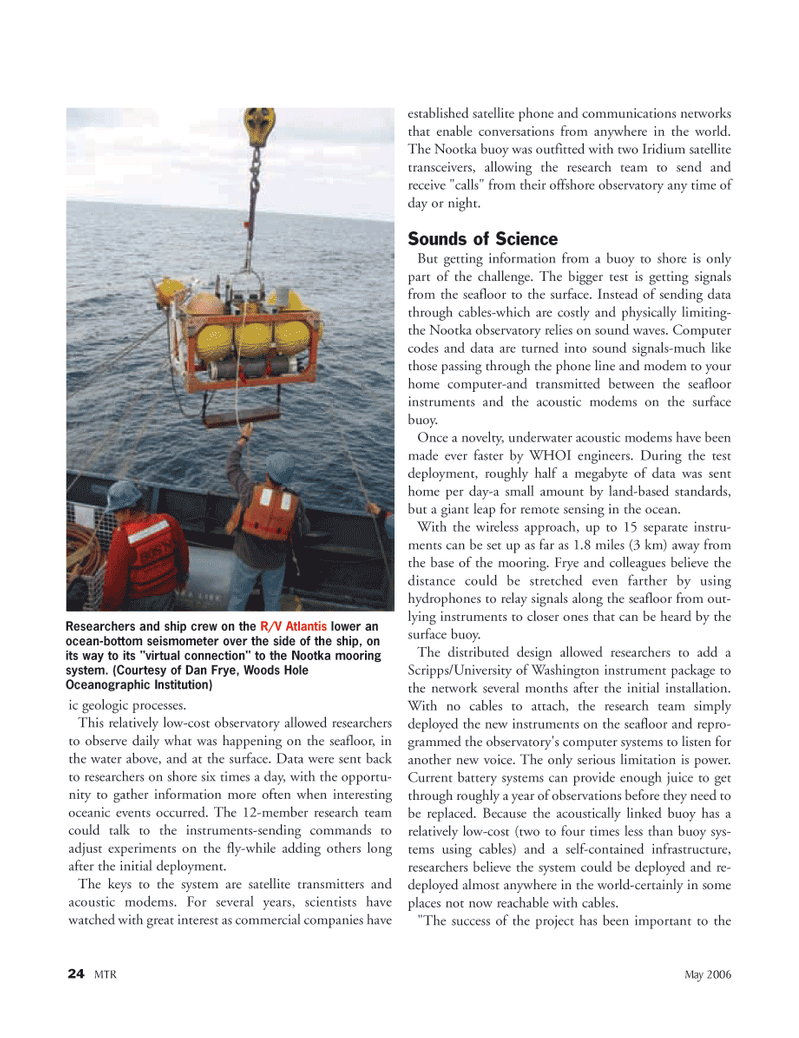
Page 24: of Marine Technology Magazine (May 2006)
The Communications Edition
Read this page in Pdf, Flash or Html5 edition of May 2006 Marine Technology Magazine
24 MTR May 2006 ic geologic processes.
This relatively low-cost observatory allowed researchers to observe daily what was happening on the seafloor, in the water above, and at the surface. Data were sent back to researchers on shore six times a day, with the opportu- nity to gather information more often when interesting oceanic events occurred. The 12-member research team could talk to the instruments-sending commands to adjust experiments on the fly-while adding others long after the initial deployment.
The keys to the system are satellite transmitters and acoustic modems. For several years, scientists have watched with great interest as commercial companies have established satellite phone and communications networks that enable conversations from anywhere in the world.
The Nootka buoy was outfitted with two Iridium satellite transceivers, allowing the research team to send and receive "calls" from their offshore observatory any time of day or night.
Sounds of Science
But getting information from a buoy to shore is only part of the challenge. The bigger test is getting signals from the seafloor to the surface. Instead of sending data through cables-which are costly and physically limiting- the Nootka observatory relies on sound waves. Computer codes and data are turned into sound signals-much like those passing through the phone line and modem to your home computer-and transmitted between the seafloor instruments and the acoustic modems on the surface buoy.
Once a novelty, underwater acoustic modems have been made ever faster by WHOI engineers. During the test deployment, roughly half a megabyte of data was sent home per day-a small amount by land-based standards, but a giant leap for remote sensing in the ocean.
With the wireless approach, up to 15 separate instru- ments can be set up as far as 1.8 miles (3 km) away from the base of the mooring. Frye and colleagues believe the distance could be stretched even farther by using hydrophones to relay signals along the seafloor from out- lying instruments to closer ones that can be heard by the surface buoy.
The distributed design allowed researchers to add a
Scripps/University of Washington instrument package to the network several months after the initial installation.
With no cables to attach, the research team simply deployed the new instruments on the seafloor and repro- grammed the observatory's computer systems to listen for another new voice. The only serious limitation is power.
Current battery systems can provide enough juice to get through roughly a year of observations before they need to be replaced. Because the acoustically linked buoy has a relatively low-cost (two to four times less than buoy sys- tems using cables) and a self-contained infrastructure, researchers believe the system could be deployed and re- deployed almost anywhere in the world-certainly in some places not now reachable with cables. "The success of the project has been important to the
Researchers and ship crew on the R/V Atlantis lower an ocean-bottom seismometer over the side of the ship, on its way to its "virtual connection" to the Nootka mooring system. (Courtesy of Dan Frye, Woods Hole
Oceanographic Institution)
MTR#4 (17-32).qxd 5/8/2006 9:54 AM Page 24

 23
23

 25
25
